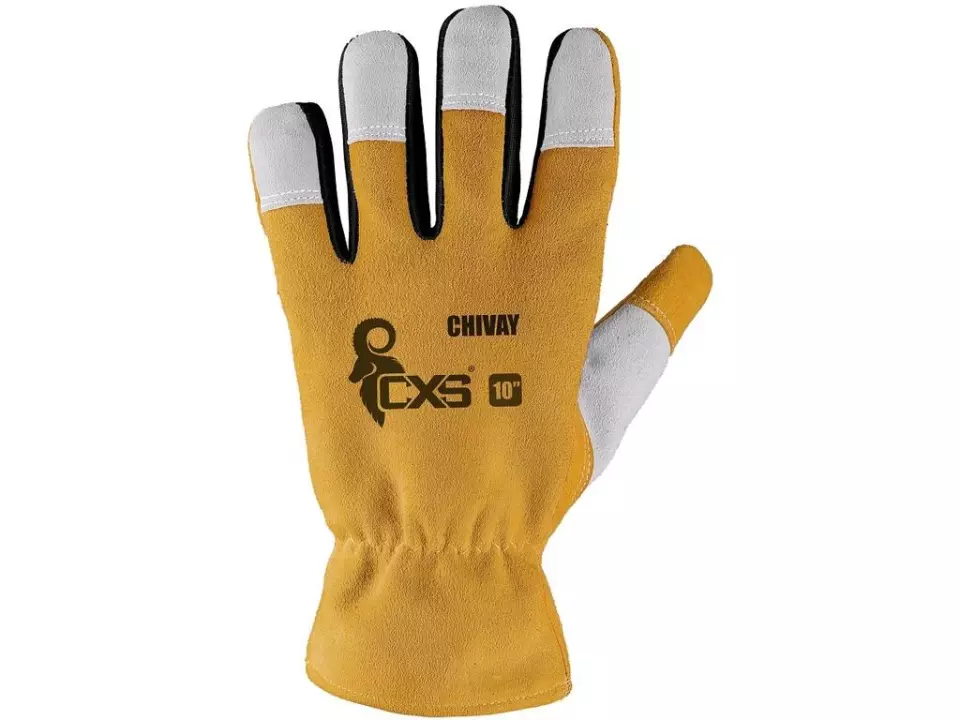CXS Chivay Winter Gloves
CXS
visit storeProduct description
Product Features:
- Leather winter gloves
- Plush lining for warmth
- Rubber cuff for secure fit
- Packed with blister
Recommended application:
Construction, logistics, work in dry and cold environments, transport, engineering, agriculture
The design of the wrist area that secures the glove and prevents debris entry. Different styles offer varying levels of adjustability, protection, and comfort.
Identifies the material covering the glove's palm area, determining grip quality, protection level, dexterity, and durability for specific work environments.
The interior fabric that contacts your skin, affecting comfort, temperature regulation, moisture control, and allergen exposure during extended wear periods.
Suited for various tasks, these gloves offer essential protection and flexibility. A practical choice providing comfort and durability for everyday use.
Provides complete hand coverage, shielding fingers from hazards. Offers maximum protection and warmth, ideal for demanding tasks and environments.
- Cold Protective
- Cut Resistant
- Hand Protection
Request a free sample
Test first and buy later. Visit any product page to request your free sample.
Standards and labels
EN 388:2016 is a European standard for measuring the performance of protective gloves against mechanical risks (abrasion, cut, tear, and puncture). The standard includes test methods and performance requirements for gloves to be considered compliant. Test results are reported using a series of four numbers, each representing the performance level achieved in one of the tests.
Test results
Cut Resistance, ISO 13997 Level XThe standard EN 388:2016, specifically its segment referring to ISO 13997 test, is designed to assess the cut resistance of materials used in protective gloves. A result denoted as 'Level X' means that test is not performed and the cut resistance of the product cannot be guaranteed.
Abrasion Resistance Level 3EN 388:2016 is a European standard that provides guidelines for assessing the protection levels of gloves against mechanical risks, such as abrasion, cuts, tears, and puncture. The Abrasion Resistance Level 3 indicates a higher level of protection, signifying that the gloves can resist more intensive wear from rough materials. According to the standard, the abrasion resistance test involves rubbing the glove material against sandpaper under a specified pressure until it is worn through. Level 3 abrasion resistance requires that the gloves withstand 2000 to 7999 cycles of abrasion. This enhanced level of durability is appropriate for tasks involving more frequent or more intense contact with abrasive surfaces, such as construction work, woodworking, and handling building materials. Gloves with Level 3 abrasion resistance offer a robust barrier against wear, extending glove life and providing increased protection for the wearer’s hands, thus reducing the risk of injuries in more demanding work environments.
Cut Resistance, Coup Test Level 1The EN 388:2016 standard is dedicated to gauging the mechanical risks for hand protection where a Cut Resistance, Coup Test Level 1 indicates minimal resistance to cutting because material achieved between 1.2 and 2.5 cycles before being cut through during the test. It means that the product tested at this level offers basic protection against shallow cuts, suitable for tasks with low risk of cut injuries. The test method used involves a rotating circular blade under a fixed force making contact with the fabric or material being tested. The blade moves back and forth across the material until a cut-through is achieved. The number of cycles required to cut through the sample at a consistent speed determines the cut resistance, with Level 1 being the second lowest rating after level 0. Products at this level are applicable in scenarios where there are minimal hazards from sharp objects, hence ideal for light duties where there is no significant risk of deep cuts.
Tear Resistance Level 1EN 388:2016 is a European standard that outlines the testing requirements for gloves to determine their level of protection against mechanical hazards, including tear resistance. The Tear Resistance Level 1 classification signifies that the gloves offer basic protection against tearing. The test method involves applying a force to a sample of the glove material to tear it, and the force measured reflects the glove's ability to resist tearing. Level 1 tear resistance means the gloves can withstand a force of between 10 to 25 Newtons before tearing. This basic level of protection is suitable for tasks where there is a minimal risk of tearing due to light manual handling or where gloves are used to prevent scratches or minor abrasions. Gloves with Level 1 tear resistance are appropriate for general activities that do not involve handling sharp or jagged materials.
Puncture Resistance Level 2The standard EN 388:2016 includes an assessment of Puncture Resistance, where Level 2 signifies that the material has met specific criteria for resistance against puncture. The result of Level 2 in puncture resistance means that the protective glove or material can withstand a force of 60 to 100 newtons before being punctured. The test method used involves using a standardized steel puncture probe that is pushed against the material at a specified speed until it pierces through it. In essence, achieving a Level 2 puncture resistance under EN 388:2006 suggests that the protective equipment offers moderate protection against punctures, making it suitable for environments where there is a risk of encountering sharp objects such as needles, but are not excessively sharp or exert very high force.
EN 511:2006 is a European standard that sets requirements for the protection against cold for gloves and mittens. It covers factors such as resistance to cold, water penetration and breathability. Testing must be done by a certified lab and must show that the product meets all requirements of the standard. Possible test results would include pass/fail for each requirement, as well as specific measurement data.
Test results
Cold Contact Level 1The standard EN 511:2006 specifies requirements for protective gloves that guard against cold environments. Cold contact performance Level 1 indicates a glove's level of protection against transmitted cold via physical contact with cold objects. For Level 1 specifically, the thermal resistance level must be above 0.025 but less than 0.050 m²°C/W. The test for this rating, known as the Contact Cold Test, involves placing the glove material on metal plates that have been pre-cooled to different specific temperatures. The temperature drop across the test sample is then measured to determine how effectively the glove insulates against cold. In practical terms, a glove achieving Level 1 in cold contact provides minimal thermal insulation, suitable for environments where exposure to slight cold is expected but not extreme cold conditions .
Convective Cold Level XThe EN 511:2006 standard specifies the requirements for protective gloves against cold, including convective cold. A specific test result of Level X under this standard generally implies that the gloves have not been measured for that specific level of protection against convective cold or did not meet the criteria to be rated at a discernible level; hence, information regarding the protection it could offer at Level X is not provided. The Convective Cold Test involved in EN 511:2006 measures the thermal insulation of gloves when exposed to cold air. This test uses an electrically heated hand model, and the power required to maintain the hand's temperature gives an indication of the glove's insulation effectiveness. The test environment is controlled with progressive cooling, and measurements are taken to assess the insulation level, categorized from Level 1 upwards. The higher the level, the greater the cold insulation offered by the glove, enabling professionals in cold environments to select gloves based on the specific insulation requirements of their workplace activities .
Water Tightness Level XThe standard EN 511:2006 defines the requirements for protective gloves against cold. The reference to a Water Tightness Level X in this standard typically indicates that the glove has not been tested for water tightness. Water tightness is assessed through a specific test method where the gloves are subjected to water exposure under controlled conditions to check for leakage. The gloves are filled with water and then inspected visually to determine the presence of any water leakage. The practical implications of a Level X result for water tightness suggest that the gloves are either not designed to be waterproof or they failed to meet the minimum criteria for being labeled as water-resistant under normal usage conditions. This information is important for procurement professionals focusing specifically on the need for water-resistant or waterproof protective gloves.
Test results
General Requirements GuideEN ISO 21420:2020 is a standard that outlines general requirements and guidelines for protective gloves, aiming to ensure their quality, performance, and suitability for various applications. When a product meets the requirements outlined in the General Requirements section of EN ISO 21420:2020, it signifies that the gloves comply with fundamental quality and performance criteria, including factors such as size, fit, ergonomics, and dexterity. The practical implications of this compliance are significant, as it assures users of the gloves' basic functionality and suitability for general hand protection purposes across a range of industries and applications. The test method involves evaluating various aspects of the gloves, including dimensions, construction, materials, and labeling, to ensure conformity with the specified requirements. Compliance with these general requirements enhances user confidence in the protective gloves' reliability and effectiveness, promoting workplace safety and facilitating compliance with regulatory standards.
CE Marking is a label that shows a product meets certain safety and environmental standards set by the European Union. To get the CE Marking, a company must test and certify their product meets these standards. CE Marking is required for many products sold in the EU, including electronics, machinery, toys and medical devices. It helps ensure that products are safe for consumers and the environment, and allows for easy trade within the EU.
PPE stands for "personal protective equipment." PPE Category 2 refers to equipment that is more complex, and has a higher level of risk. Examples of PPE Category 2 include safety helmets, ear protection, and fall arrest equipment. In Europe, PPE Category 2 must meet certain safety standards set by the European Union, which means that it must be designed and manufactured to protect the user without causing harm. Companies that make or sell PPE must prove that it meets these standards. They also must have a quality management system in place and have to be audited regularly by a notified body.
CXS delivery terms
Free delivery when you order more than 1 650,00 kr from CXS
Supplier shipping fee 60,00 kr
Brand minimum 2 000,00 kr
107,50 kr
Shipping fee is 60,00 kr for orders under 1 650,00 kr
Sold in units of one pair
Need larger quantities?
Other products you may like
Recently viewed
Need help?
Get help from our experts
Other products you may like
Similar products you may like
Recommended for you
CXS
Delivery time: 7 business days
Orders from 2 000,00 €
Supplier shipping fee 60,00 €
Free shipping on orders over 1 650,00 €



Find +150,000 products from hundreds of brands
Autonomous sourcing platform
The most efficient way to source and order supplies for your operations
Sourcing
Ordering
List products you’re looking for and we’ll find the best products and prices for you – all for free.
Need help?
Get help from our experts

